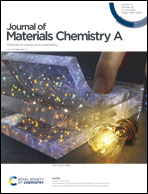Rational design of porous CexNb1−x oxide hollow nanospheres as a novel NH3-SCR catalyst†
Abstract
The morphology and hierarchical structure of materials play an important role in catalytic behaviors. Herein, a series of porous CexNb1−x (x = 0, 0.2, 0.4, 0.6, 1) hollow nanospheres were designed by a modified seed-mediated growth approach and tested for selective catalytic reduction of NOx with NH3 (NH3-SCR). XRD, TEM, BET, Raman, H2-TPR, NH3-TPD, XPS and in situ DRIFTS were carried out to explore the physicochemical properties of the prepared bimetal oxides. A strong interaction between Nb2O5 and CeO2 affected the oxygen defects, valence, reducibility, and the number of acid sites. Among the obtained catalysts, the porous Ce0.4Nb0.6 nanospheres with more acid sites and excellent reducibility exhibited superior catalytic activity with NOx conversion of more than 98% in the temperature range of 250–450 °C and high catalytic stability for H2O and SO2, which can be attributed to the porous double-shell structure, and the strong interaction of Nb2O5 and CeO2 species. Furthermore, in situ DRIFTS results revealed that the NH3-SCR reaction on Ce0.4Nb0.6 oxide followed the Eley–Rideal mechanism. The results of this work could further provide a strategy for the design and synthesis of materials with hollow and porous structures for various applications.



 Please wait while we load your content...
Please wait while we load your content...